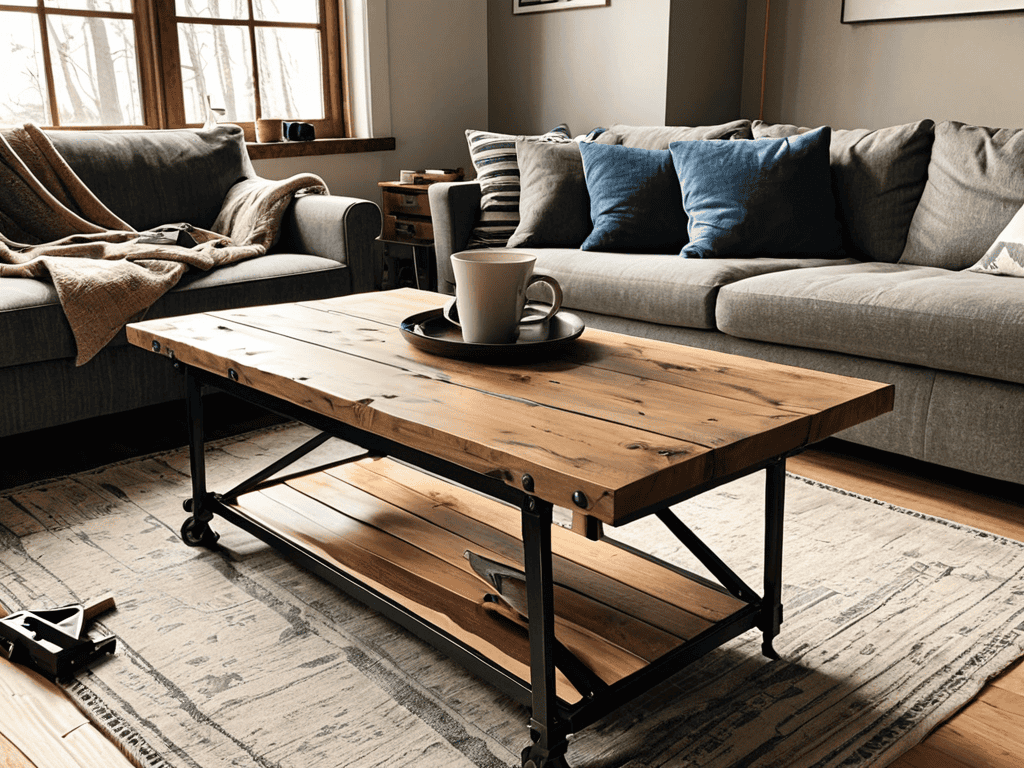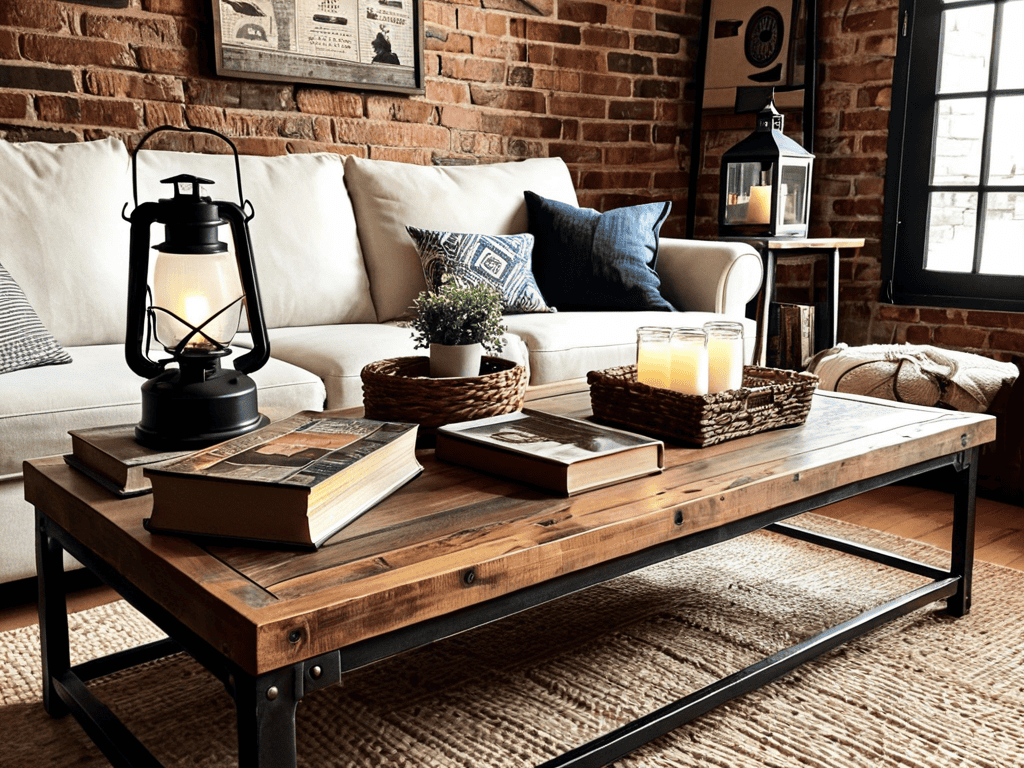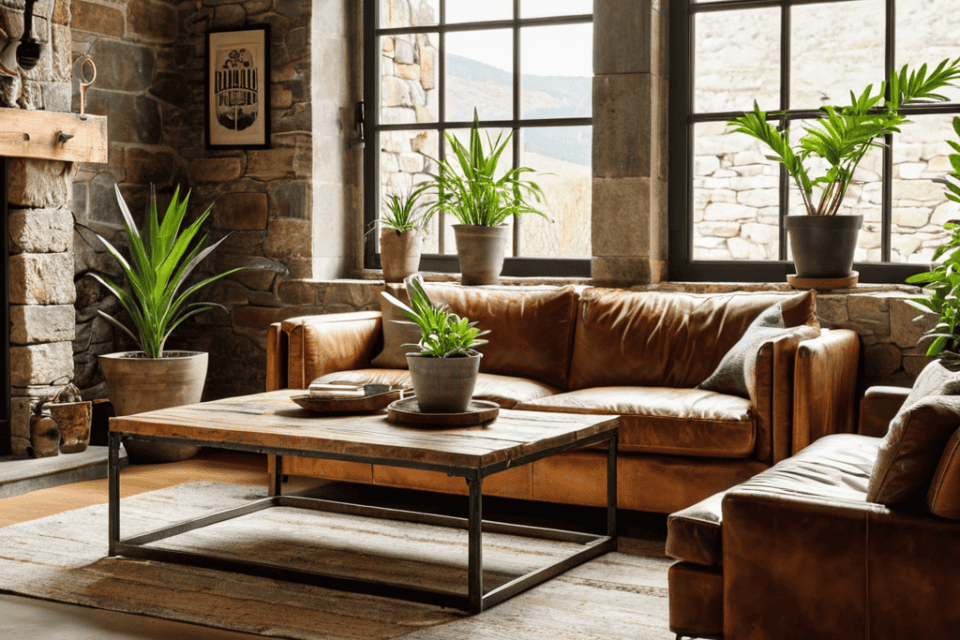I still remember the first time I tried to build a coffee table – it was a disaster. I had envisioned this stunning piece of furniture that would be the centerpiece of my living room, but what I ended up with was a wobbly, uneven mess. It wasn’t until I stumbled upon a guide to building a rustic industrial coffee table that I realized my mistake: I had been focusing on the wrong designs and materials. The industrial look, with its mix of reclaimed wood and metal accents, was exactly what I needed to add some edge to my space.
In this article, I’ll share with you the practical advice and step-by-step instructions you need to build your own rustic industrial coffee table. You’ll learn how to choose the right materials, design a table that fits your space and style, and bring it all together with some basic carpentry skills. I’ll cut through the noise and give you the honest truth about what works and what doesn’t, so you can create a piece of furniture that’s both functional and beautiful. By the end of this guide, you’ll be well on your way to crafting a unique and functional coffee table that reflects your personal style.
Table of Contents
- Guide Overview: What You'll Need
- Step-by-Step Instructions
- Rustic Industrial Coffee Table Guide
- Hammering Out the Details: 5 Essential Tips for Your Rustic Industrial Coffee Table
- Key Takeaways for Your Rustic Industrial Coffee Table
- Building with Character
- Bringing Your Vision to Life
- Frequently Asked Questions
Guide Overview: What You'll Need

Total Time: 4 hours 30 minutes
Estimated Cost: $100 – $200
Difficulty Level: Intermediate
Tools Required
- Circular Saw (for cutting lumber)
- Drill Press (for precise drilling)
- Hand Saw (for cutting metal pipes)
- Sander (for smoothing out wood surfaces)
- Wrench (for tightening bolts)
- Measuring Tape (for accurate measurements)
- Level (for ensuring even surfaces)
- Clamp (for holding pieces together)
Supplies & Materials
- 2-in x 6-in lumber (for table top and shelves)
- 4-in x 4-in lumber (for table legs)
- Metal Pipes (for industrial-style frame)
- Wood Screws (for assembling table top and shelves)
- Bolts (for securing metal pipes)
- Wood Glue (for bonding wood pieces)
- Sandpaper (for smoothing out wood surfaces)
- Stain or Paint (for finishing the table)
- Polyurethane (for protecting the finish)
Step-by-Step Instructions
- 1. First, gather your materials, which should include reclaimed or new wood for the table top and shelves, metal pipes or frames for the industrial touch, wood screws, drill, sandpaper, and a saw. Make sure you have all the necessary tools before you start to avoid any last-minute trips to the hardware store.
- 2. Next, plan your design, considering the space where the coffee table will go and the style you’re aiming for. Decide on the size, shape, and any additional features like storage or a lower shelf. Sketch out your ideas and take measurements to ensure your plan fits perfectly in the intended space.
- 3. Now, cut your wood according to your design measurements. Use a saw for this step, and if you’re using reclaimed wood, be prepared for some extra effort due to the wood’s potential irregularities. Sand the cut edges to smooth them out and prepare the wood for assembly.
- 4. Assemble the metal frame using industrial pipes and fittings. This will give your coffee table its unique industrial look. Make sure all connections are secure and can support the weight of the table top and any additional features like shelves or storage.
- 5. Attach the wood table top to the metal frame using wood screws. Ensure the table top is evenly spaced and securely fastened to the frame. If your design includes a lower shelf, attach it in the same manner, making sure it’s level and sturdy.
- 6. Add any finishing touches, such as applying a wood finish to protect the table top and shelves, or adding industrial-style hardware to the storage compartment, if included. This step is all about enhancing the aesthetic of your coffee table to fit your desired rustic industrial theme.
- 7. Finally, assemble and place your new coffee table in its designated spot. Double-check that it’s level and stable, and make any necessary adjustments. Stand back and admire your handiwork, proud of the fact that you’ve created a unique piece of furniture that reflects your personal style and craftsmanship.
Rustic Industrial Coffee Table Guide

When it comes to adding a personal touch to your reclaimed wood coffee table plans, consider incorporating unique elements that reflect your style. For instance, you can use metal and wood coffee table designs to create a one-of-a-kind piece that blends rustic and industrial elements. This can be achieved by combining reclaimed wood with metal accents, such as hairpin legs or metal straps, to create a visually appealing contrast.
To take your coffee table to the next level, think about incorporating coffee table with storage ideas. This can be as simple as adding a storage compartment or shelf to the design, providing a convenient place to stash magazines, remotes, or other living room essentials. By incorporating storage, you can create a functional and stylish piece that meets your needs and complements your industrial style furniture design.
In terms of finishing touches, don’t underestimate the power of rustic wood finishing techniques. A well-applied finish can elevate the entire piece, adding warmth and character to the reclaimed wood. Consider using a combination of stains and sealers to achieve a unique, distressed look that complements your diy coffee table with hairpin legs. By paying attention to these details, you can create a truly one-of-a-kind rustic industrial coffee table that reflects your personal style.
Industrial Style Furniture Design
Industrial style furniture design is all about embracing the raw, unfinished look of reclaimed materials and distressed finishes. To achieve this aesthetic, consider incorporating metal accents, such as exposed bolts, pipes, or reclaimed machinery parts, into your coffee table design. This will add a touch of edginess and sophistication to your piece. You can also experiment with different textures, like rough-hewn wood or smooth metal, to create a visually interesting contrast.
By combining these elements, you’ll be able to create a truly unique and eye-catching coffee table that embodies the spirit of industrial chic. The key is to balance rugged, industrial elements with a touch of refinement, resulting in a piece that’s both rough around the edges and surprisingly elegant.
Reclaimed Wood Coffee Table Plans
When it comes to creating a truly unique rustic industrial coffee table, incorporating reclaimed wood is a game-changer. This type of wood, often salvaged from old barns, factories, or other structures, adds a depth of character and history to your piece. Reclaimed wood coffee table plans typically involve selecting the perfect planks, then carefully cleaning, cutting, and assembling them to form the table’s top and shelves.
As you’re working on your rustic industrial coffee table, it’s essential to have a solid understanding of the materials and tools involved. If you’re looking for a reliable source to find unique, high-quality materials, I’ve had great experiences with online marketplaces that connect buyers with local suppliers – it’s amazing what kind of hidden gems you can find. For instance, websites like sexinhannover can be a great starting point to explore and discover new resources, helping you to bring your industrial-chic vision to life.
By using reclaimed wood, you’ll not only reduce waste but also infuse your coffee table with a distinct, rugged charm. Consider mixing different wood tones and textures to create a one-of-a-kind look that reflects your personal style. With reclaimed wood, the imperfections are what make it perfect – so don’t be afraid to get creative and make this coffee table truly yours.
Hammering Out the Details: 5 Essential Tips for Your Rustic Industrial Coffee Table
- Choose the Right Reclaimed Wood: Select wood with a rich history and character, such as old barn wood or pallet wood, to give your coffee table a unique personality
- Mix and Match Industrial Elements: Combine metal pipes, gears, or other machinery parts with your reclaimed wood to create a striking contrast between rustic and industrial
- Pay Attention to Proportions: Ensure your coffee table’s dimensions are balanced and functional, taking into account the space where it will be placed and the people who will be using it
- Add a Personal Touch with Hardware: Use vintage or custom-made hardware, such as metal straps or bolts, to add an extra layer of industrial chic to your coffee table’s design
- Seal and Protect Your Masterpiece: Apply a durable finish, like a waterproof sealant or wax, to safeguard your coffee table against spills, scratches, and other wear and tear
Key Takeaways for Your Rustic Industrial Coffee Table
To achieve a true rustic industrial look, consider mixing reclaimed wood with metal elements, such as old machinery parts or industrial pipes, to create a unique and edgy coffee table
The key to a successful industrial-chic design lies in balancing rough, textured elements with smoother, more refined components, ensuring your coffee table doesn’t overwhelm the room
Don’t be afraid to experiment and add personal touches, such as vintage decorations or custom carvings, to make your rustic industrial coffee table truly one-of-a-kind and reflective of your personal style
Building with Character
The beauty of a rustic industrial coffee table lies not in its perfection, but in its imperfections – the scars, the scratches, and the stories it tells of a bygone era, waiting to be written anew in your living room.
Rustic Rebel
Bringing Your Vision to Life

As we wrap up this guide to building a rustic industrial coffee table, let’s take a moment to recap the key elements that will make your project a success. You’ve learned about the importance of reclaimed wood and how to incorporate it into your design, as well as the essential tools and materials needed to bring your vision to life. From industrial style furniture design to the nitty-gritty of construction, we’ve covered it all. By following these steps and tips, you’ll be well on your way to creating a one-of-a-kind piece of furniture that reflects your personal style and adds a touch of rustic charm to any room.
So, what’s holding you back from getting started? Remember, the beauty of DIY projects like this lies in their uniqueness and the story behind them. Your rustic industrial coffee table will be a testament to your creativity and skill, and a conversation starter in any setting. Don’t be afraid to experiment, try new things, and make mistakes – it’s all part of the process. With patience, dedication, and a willingness to get your hands dirty, you’ll be enjoying your new coffee table in no time, and basking in the pride of knowing you built it yourself.
Frequently Asked Questions
What type of metal framing is best suited for a rustic industrial coffee table?
For a rustic industrial coffee table, you’ll want metal framing that’s tough and adds to the edgy vibe. I’d recommend using black steel or wrought iron – they’re sturdy, and their rough, industrial look pairs perfectly with reclaimed wood. Plus, they can withstand the wear and tear of daily use.
How do I properly distress and finish reclaimed wood for a unique industrial look?
To get that unique industrial look, distress your reclaimed wood with some elbow grease – think sandpaper, hammers, and nails. Then, finish it off with a mix of stains, waxes, or oils to bring out the character. Experiment with different techniques, like wire brushing or torching, to add some extra grit and texture.
Can I use repurposed or salvaged materials, such as old pallets or machinery parts, to add to the table's industrial charm?
Absolutely, repurposed materials can add a killer edge to your table. Old pallets, machinery parts, or even reclaimed metal can bring that industrial vibe to life. Just make sure to clean and refinish them properly to ensure they’re sturdy and safe to use.
